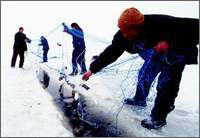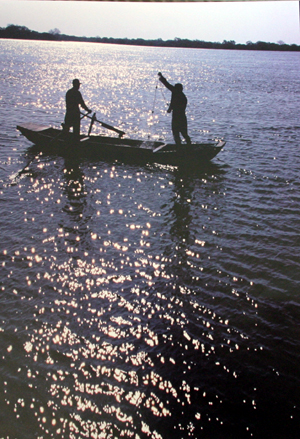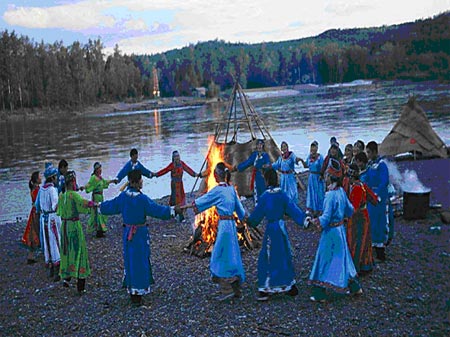| Tools: Save | Print | E-mail | Most Read |
| Pretty in Salmon |
| Adjust font size: |
While an unusual choice, there are literally thousands of vacations you can plan that revolve around fish: Head to Japan to brave a puffer fish roll, vacation in Oregon and Washington States to see Pacific salmon run, journey to Scandinavia for a pungent bite of pickled herring or strap on a tank in Australia and visit the deep blue. A lesser known destination for fish aficionados is in northeast
There are 4,200 Hezhe people left today. This Hezhe community is made up of a tiny collection of solid one-story buildings and a few mud houses with thatched roofs. Only four of the women still know how to make the traditional fish skin clothes. You Wenfeng, 55, has made 15 sets of traditional Hezhe fish skin clothing in her life, mainly for museums in
"In the old days," says You, "our clothes lasted 10 years, but our shoes only two. As for the smell, it goes away in a month." The material is surprisingly soft and strong. You's grandmother taught her how to manipulate fish skin into clothing when she was 21, after a Chinese museum asked for some specimens. Today she is teaching her daughter-in-law this craft. The best skins are from live salmon caught in late September in nets in the After her family helps her skin and scale the fish, they carefully scrape the insides clean with a knife and dry them flat in straight lines. Drying takes at least a day in the sun. To soften them, they cover the fish skins in corn flour and then roll and mash them in a wooden, jaw-like instrument called a "mu he" in Putonghua and a "ge ji kou" in the Hezhe language. They also make the skin flexible by rubbing the pieces together by hand. Then comes the cutting. You does not use a pattern or glue, but puts the pieces together from memory and sews them by hand with cotton thread. It took You 20 days to make each set of children's clothing from the skin of the soft underbelly of the fish. The clothing she makes for museums have no chemicals and the color will darken with age. You and her friend demonstrate the local fishing industry in dance form for visiting tourists. For more local flavor, the village offers a museum and store with fish bone sculptures and modern fish skin shoes and purses, made in south China from Heilongjiang fish skins.
Another and larger museum about the Hezhe people is just outside the nearby city of To live off of the land is one thing, but to live off of the fish is something all those interested in our finned friends should see. Travel Tips Getting there: Fly directly to Where to stay: The Heilongjiang China International Travel Service can help arrange a stay in the village with one of the Hezhe families or at a nearby hotel. What to eat: The salmon not only looks good on, but is delicious and fresh to eat. Where to play: The museums give a decent overview of the Hezhe people, but hanging out with the villagers in their homes was just as educational and more fun. (City Weekend by Ruth Lor Malloy March 9, 2007)
|
| Tools: Save | Print | E-mail | Most Read |
 |
| Related Stories |
|
Product Directory China Search |
Country Search Hot Buys |


